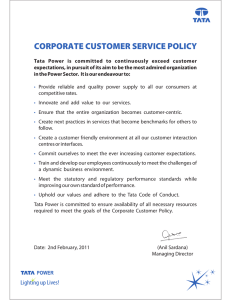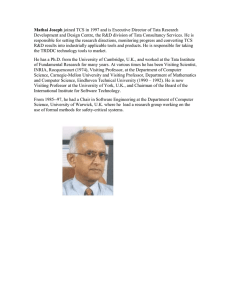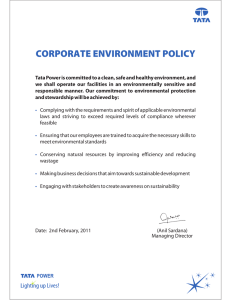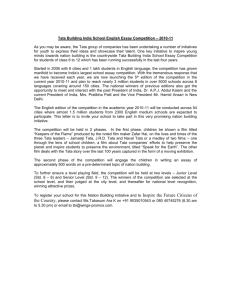15 The House of Tata
advertisement
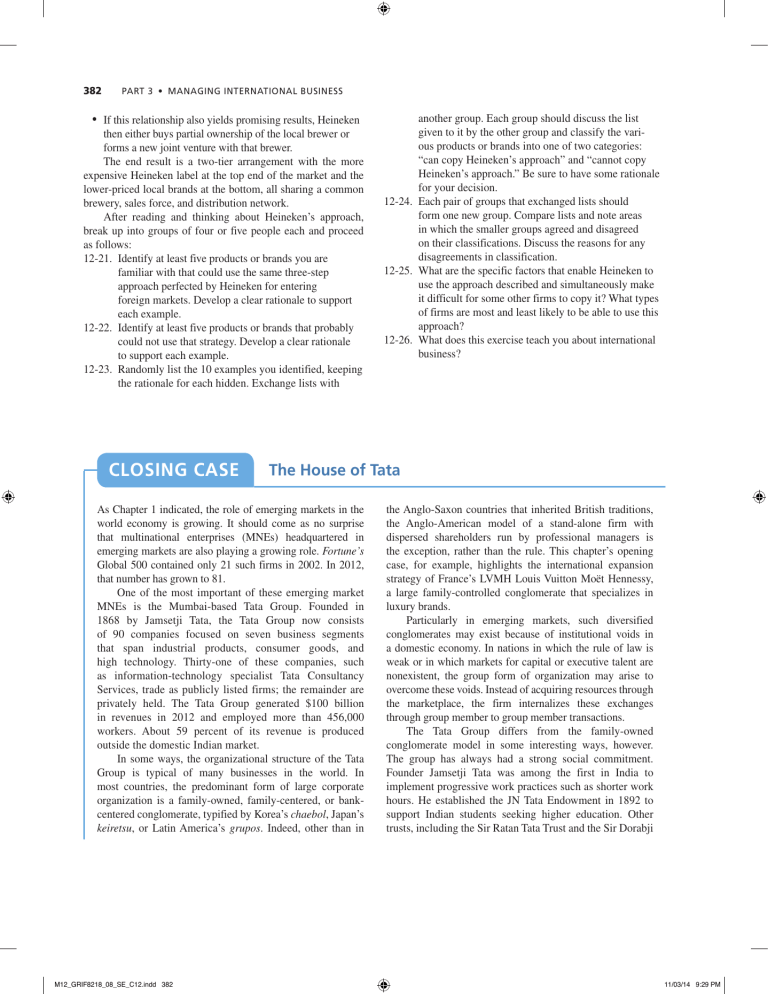
382 Part 3 • Managing International Business • If this relationship also yields promising results, Heineken then either buys partial ownership of the local brewer or forms a new joint venture with that brewer. The end result is a two-tier arrangement with the more expensive Heineken label at the top end of the market and the lower-priced local brands at the bottom, all sharing a common brewery, sales force, and distribution network. After reading and thinking about Heineken’s approach, break up into groups of four or five people each and proceed as follows: 12-21. Identify at least five products or brands you are ­familiar with that could use the same three-step ­approach perfected by Heineken for entering ­foreign markets. Develop a clear rationale to support each example. 12-22. Identify at least five products or brands that probably could not use that strategy. Develop a clear rationale to support each example. 12-23. Randomly list the 10 examples you identified, ­keeping the rationale for each hidden. Exchange lists with Closing Case The House of Tata As Chapter 1 indicated, the role of emerging markets in the world economy is growing. It should come as no ­surprise that multinational enterprises (MNEs) headquartered in emerging markets are also playing a growing role. Fortune’s Global 500 contained only 21 such firms in 2002. In 2012, that number has grown to 81. One of the most important of these emerging m ­ arket MNEs is the Mumbai-based Tata Group. Founded in 1868 by Jamsetji Tata, the Tata Group now consists of 90 ­ companies focused on seven business segments that span industrial products, consumer goods, and high ­ technology. Thirty-one of these companies, such as ­ information-technology specialist Tata Consultancy Services, trade as publicly listed firms; the remainder are privately held. The Tata Group generated $100 billion in revenues in 2012 and employed more than 456,000 workers. About 59 percent of its revenue is produced ­ ­outside the domestic Indian market. In some ways, the organizational structure of the Tata Group is typical of many businesses in the world. In most countries, the predominant form of large corporate organization is a family-owned, family-centered, or bankcentered conglomerate, typified by Korea’s chaebol, Japan’s ­keiretsu, or Latin America’s grupos. Indeed, other than in M12_GRIF8218_08_SE_C12.indd 382 a­ nother group. Each group should discuss the list given to it by the other group and classify the various ­products or brands into one of two categories: “can copy Heineken’s approach” and “cannot copy Heineken’s approach.” Be sure to have some rationale for your decision. 12-24. Each pair of groups that exchanged lists should form one new group. Compare lists and note areas in which the smaller groups agreed and disagreed on their c­ lassifications. Discuss the reasons for any ­disagreements in classification. 12-25. What are the specific factors that enable Heineken to use the approach described and simultaneously make it difficult for some other firms to copy it? What types of firms are most and least likely to be able to use this approach? 12-26. What does this exercise teach you about international business? the Anglo-Saxon countries that inherited British traditions, the Anglo-American model of a stand-alone firm with dispersed shareholders run by professional managers is ­ the exception, rather than the rule. This chapter’s opening case, for example, highlights the international expansion strategy of France’s LVMH Louis Vuitton Moët Hennessy, a large family-controlled conglomerate that specializes in luxury brands. Particularly in emerging markets, such diversified ­conglomerates may exist because of institutional voids in a domestic economy. In nations in which the rule of law is weak or in which markets for capital or ­executive talent are nonexistent, the group form of organization may arise to overcome these voids. Instead of acquiring ­resources through the marketplace, the firm internalizes these exchanges through group member to group member transactions. The Tata Group differs from the family-owned ­conglomerate model in some interesting ways, however. The group has always had a strong social commitment. Founder Jamsetji Tata was among the first in India to implement progressive work practices such as shorter work hours. He established the JN Tata Endowment in 1892 to support Indian students seeking higher education. Other trusts, ­including the Sir Ratan Tata Trust and the Sir Dorabji 11/03/14 9:29 PM Chapter 12 • Strategies for Analyzing and Entering Foreign Markets 383 Tata Trust, were created by his descendants to support initiatives in health, education, scientific research, and ­ other fields. Various charitable trusts established by the Tata family now own two-thirds of Tata Sons, which in turn owns controlling interest in various companies that constitute the Tata Group. Each Tata company operates as an independent entity, with its own management team, board of directors, and shareholders. The Tata Group, however, is proud of and concerned about maintaining the integrity of the Tata brand. To be able to use the Tata name, the independent companies must act according to the Tata Business Excellence Model. Individual employees must sign the Tata Group Code of Contact, which stresses the importance of integrity, understanding, excellence, unity, and responsibility. This commitment to integrity was heightened when Ratan Tata took over leadership of the Tata Group two decades ago. He confronted a sprawling confederation of some 300 companies. He immediately sought to seek synergies from the firms in this diverse empire, while selling off unprofitable and underperforming units. Ratan Tata decided that many of the Tata companies had become inefficient, having been protected by the high tariff walls erected by the Indian government (see page 67). He set about to improve the competitiveness of the group’s firms by investing in R&D, improving training, and strengthening the Tata brand, particularly outside of India. A key element of Ratan Tata’s brand-strengthening strategy was to acquire foreign companies to aid the competitiveness of firms within the Tata Group. In 2000, Tata Tea acquired Britain’s Tetley Tea for $432 million. In 2004, Tata Motors purchased the struggling heavy vehicles unit of Daewoo Motors; in 2008, it purchased the Land Rover and Jaguar brands from Ford Motor Company for $2.3 billion. Tata Chemicals purchased control of Britain’s Brunner Mond Group in 2005. In 2005, Tata Steel acquired Singapore’s NatSteel for $300 million; in 2007, it ­purchased steel giant Corus, an Anglo-Dutch company, for $13 billion. Unlike many acquirers, Tata often leaves the management teams of its acquired businesses intact, but ­provides corporate support, investment capital, or other needed resources. It usually sends Tata managers to learn from the new subsidiaries. In the case of Tetley, Tata was interested in learning about tea cultivation, product branding, and export development. Tata Global Beverages is now the world’s second-largest seller of tea. In Corus’ case, it was to learn about producing higher-quality steel to meet the growing needs of India’s motor vehicle industry. Tata Steel is now the world’s 10th-largest producer of that product. And, to the surprise of many industry experts, Tata has made M12_GRIF8218_08_SE_C12.indd 383 Jaguar Land Rover an important player in the luxury automobile market. It sold 358,000 vehicles in 2012, up 30 percent from the previous year. The auto company is investing $219 million in a new British engine manufacturing ­center to boost the performance while lowering the e­ missions of its engines. The Tata Group’s biggest challenge may be the loss of its dynamic leader. Ratan Tata retired as the chairman of the group at the end of 2012. His successor, Cyrus Mistry, is the first non-family member to chair the group. Needless to say, Mistry has some big shoes to fill. Case Questions 12-27. What advantages does the Tata Group gain from ­being a conglomerate? 12-28. What are institutional voids? Why might they ­encourage the conglomerate form of organization in emerging markets? 12-29. Many corporate takeovers involve the ­acquiring firm installing its own m ­ anagers and ­slashing the payrolls of the acquired firm. Why has Tata ­chosen to retain the existing ­management teams of the ­foreign companies it has taken over? 12-30. The Tata Group has a strong commitment to high ethical standards and corporate social ­responsibility. Does it gain any competitive ­advantages in the ­marketplace because of this commitment? 12-31. What advice would you give to Cyrus Mistry, Rajan Tata’s successor? What are the primary ­challenges that Mistry faces? What changes, if any, would you recommend to make to the Tata Group’s policies and procedures? Sources: “Dream on wheels,” The Economist, April 20, 2013; “Tata Consultancy Profit Tops Forecast,” Wall Street Journal, April 17, 2013; www.tata.com accessed on April 15, 2013; “Jaguar Land Rover Increasing Engine Plant Investment,” Wall Street Journal, March 5, 2013; “Tata Pushes Upscale SUVs,” Wall Street Journal, February 13, 2013, p. B8; “The patriarch of Indian business—a hard act to follow,” Financial Times, December 27, 2012, p. 5; “Ratan Tata’s legacy,” The Economist, December 1, 2012; “From pupil to master,” The Economist, December 1, 2012; “Tata: Building an auto empire in India,” money.cnn.com, April 18, 2011; “A new kind of global company is on the rise: Diversified ­multinationals from emerging markets,” The Economist, March 5, 2011; “Ratan Tata turned a family conglomerate into a tiger,” The Economist, August 14, 2010; “Troublesome trophy,” Financial Times, July 31, 2009, p. 6; “Pharaoh capitalism,” The Economist, February 12, 2009 (online); www.tata.com; “Merger, Indian style: Buy a brand, leave it alone,” Wall Street Journal, March 22, 2008, p. 9. 11/03/14 9:29 PM
